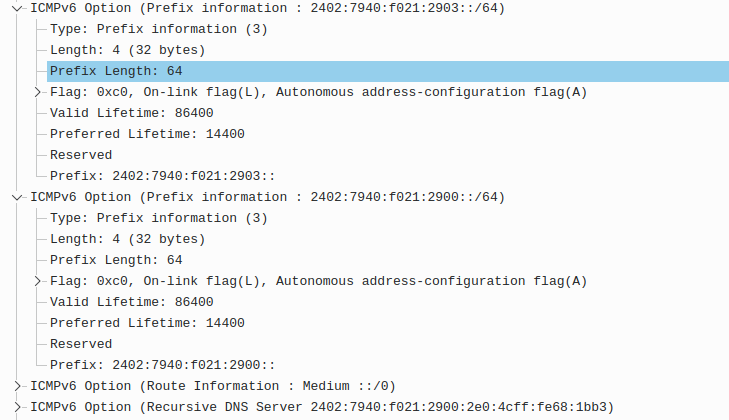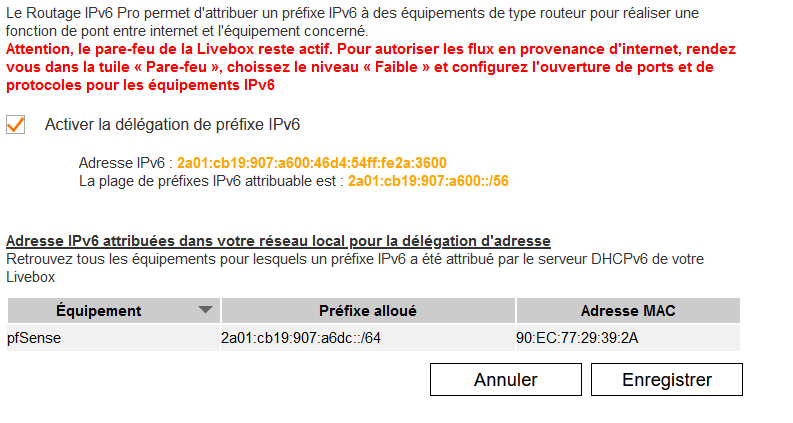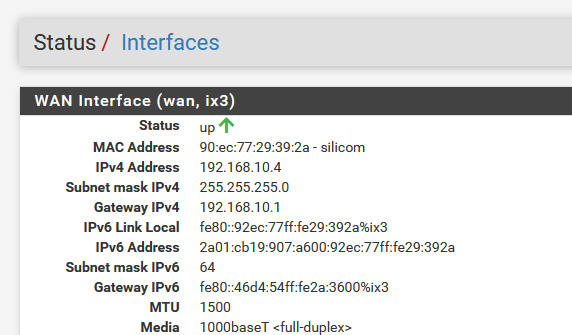prefix length should be 64
-
@JKnott said in prefix length should be 64:
@gregeeh said in prefix length should be 64:
Done, this and no more "prefix length should be 64" messages. However, LAN clients now don't have access to IPv6 Addresses.
Run Packet Capture on your LAN, filtering on ICMP6, and post the capture file here.
-
The first thing that caught my eye is you have 2 prefix information blocks. That shouldn't be a problem except they're for different /64 GUAs. I have 2 here too, but one's GUA and the other is ULA.

One ends in 2900 and the other 2903. According to the RDNSS line, the LAN is 2900.
Perhaps you can show us your RA page.
-
@JKnott said in prefix length should be 64:
The first thing that caught my eye is you have 2 prefix information blocks.
First off, thanks for taking the time to help me with this, much appreciated.
Should one block be deleted and if so how?
This RA subnet has me confused, as does it not depend on what IPv6 my ISP gives me and if so what happens if the IPv6 changes. Just all confused about this.
Anyhow , here's the RA page:

I disabled Use IPv4 connectivity as parent interface in the WAN Interface and it looks like it's working at the moment. Will need to do some further testing.
Here's the Interface Status:

-
@gregeeh said in prefix length should be 64:
I disabled Use IPv4 connectivity as parent interface in the WAN Interface and it looks like it's working at the moment. Will need to do some further testing.
Don't do that. By disabling that, you are turning off the prefix that's automatically assigned. You also have a prefix in the subnet box. This is causing 2 prefixes to be sent out, one based on the prefix ID from the /56 and the one you added. I use that box for adding a ULA prefix to my network. If you're not using ULA, don't put anything in that box.
-
@JKnott said in prefix length should be 64:
Don't do that. By disabling that, you are turning off the prefix that's automatically assigned. You also have a prefix in the subnet box.
OK, have enabled Use IPv4 connectivity as parent interface again and removed the subnet.
Cannot access IPv6 sites from pfSense nor LAN Clients.
Here are the relevant screenshots, I think I included everything.
Have also included the latest Packet Capture.
packetcapture-re1-20230811135736.pcap
I'm not using ULA.
-
@gregeeh With changes to IPv6 you sometimes have to reboot pfSense and the hosts. Do not wait for RA and Request ... through IPv4 connectivity are ISP specific. I don't think there is a general recommendation, you have to try.
fe80 for gateway is right and it is good, that your monitoring address is not the gateway address. -
@Bob-Dig said in prefix length should be 64:
With changes to IPv6 you sometimes have to reboot pfSense
Thanks for your reply.
Yes, I have discovered this and alway reboot after making changes.
I have tried all combinations of Use IPv4 connectivity as parent interface and Do not wait for a RA without luck.
-
@gregeeh But you have said that it does work at least some of the time. The gateway check with googles dns should be enough for testing this, skip the "LANs" for now. Also the "modem" gives you almost all of the relevant informations, which is good.
-
@JKnott has previoiusly suggested I should not disable Use IPv4 connectivity as parent interface.
@JKnott said in prefix length should be 64:
Don't do that. By disabling that, you are turning off the prefix that's automatically assigned.
-
-
@gregeeh said in prefix length should be 64:
@JKnott has previously suggested I should not disable Use IPv4 connectivity as parent interface.
Same thing for me.
I have to disable = uncheck that option. If checked it : no more IPv6.(my) Long story short :
My ISP router :

What I make of this : My ISP has a 2a01:cb19:907:a600::/56 for me.
It uses the first '00' prefix for the ISP router LAN : 2a01:cb19:907:a600:46d4:54ff:fe2a:3600The 90:EC:77:29:39:2A is that MAC of my pfSense WAN :
My pfSense IPv6 WAN interface :

The stupid thing is : whatever I do, my ISP router communicates just one prefix, the 'a6dc' for pfSense. Not the a601, or a6ff, only 'dc', so I can only use IPv6 on my pfsense LAN, and no Ipv6 on others LANs, as I need more prefixes for that.
dhcp6c logs on pfSense show me that It asks for more (I've used a hand crafted dhcp6c config file to do so) but that was a no-go.
And its gets way better : the IPv6 firewall on the ISP router does not permit me to create pass rules for IPv6 addresses or network using the prefix it handed over to pfSense.
These issues are known on the french support forum .... -
@gregeeh said in prefix length should be 64:
This RA submit has me confused, as does it not depend on what IPv6 my ISP gives me and if so what happens if the IPv6 changes. Just all confused about this.
It is normal to use 'what IPv6 my ISP gives' in the land of IPv6. The ISP should provide a reserved /48 block for you and this should not change. Technically you could set this block without DHCPv6 but it would be unwise and not generally recommended.
There is always a sideways look at an RFC 'should' statement and, as you have been already been exposed to, many ISPs assign a /56 (giving you a smaller block to work with) as this option was given some formal weight by the later RFC6177. Nobody likes a nibble.
I also hear stories of some US ISPs providing a daft /64 block. There is no excuse for this as there are enough /48 for everything and everyone.
 ️
️ -
A /48 is 65535 prefixes, or 65535 LANs using 2^64 IPs for every LAN, right ?
A /56 is 'just' 255 LANs for the end user.The typical SOHO Internet connection : I wonder what needs to be invented so that 255*(2^^64) isn't enough anymore

-
@Gertjan said in prefix length should be 64:
my ISP router communicates just one prefix
Technically you could use that for NPt.
-
@Gertjan said in prefix length should be 64:
@RobbieTT
A /56 is 'just' 255 LANs for the end user.The typical SOHO Internet connection : I wonder what needs to be invented so that 255*(2^^64) isn't enough anymore

It's that kind of presumption that brought about the folly of the revised RFC that made an unsupported leap of 'IPv6 address exhaustion' and worked backwards to the idea that a new measure of IPv4-esq address conservation was needed that the original IPv6 designers must have missed with their /48 per site recommendation.
This turned the original logic of the IPv6 design on its head. The underlying maths even managed to forget that almost all the GUA beyond the (then) original
2001:block was held in reserve!This is an old article on the subject but it encapsulates my thoughts to this day:
More importantly it leads to this situation:
@Gertjan said in prefix length should be 64:
What I make of this : My ISP has a 2a01:cb19:907:a600::/56 for me.
It uses the first '00' prefix for the ISP router LAN : 2a01:cb19:907:a600:46d4:54ff:fe2a:3600
The stupid thing is : whatever I do, my ISP router communicates just one prefix, the 'a6dc' for pfSense. Not the a601, or a6ff, only 'dc', so I can only use IPv6 on my pfsense LAN, and no Ipv6 on others LANs, as I need more prefixes for that.
Which is you struggling to get beyond a single subnet with the slightly more confusing /56 block and the less distinct nibble boundaries, in the more readable hex format, that is representing a long binary address.
So you may think a /56 is more than adequate for the decades to come, yet you yourself are struggling to get beyond a single subnet. You are not exactly a good advert for the merits of a /56 or the perils of the nibble boundaries. This IPv6 stuff is supposed to be understandable by every connected household, a limitation that the original IPv6 designers did understand.

(Hint: 2a01:cb19:907:a6 is the bounded nibble for your /56 prefix)
 ️
️ -
I see you have the MTU set on the WAN. It won't hurt anything unless you're on ADSL or other connection that requires a less than 1500 MTU, but it's not needed.
I also see you're using prefix ID 3, which explains why the packet capture shows :2903 for the LAN prefix. That's fine.
Why do you have question marks next to the gateway? Using link local addresses for routing is entirely normal.
On RA, why do you have stateless? That implies you're using DHCP6, but you don't have it enabled. I use unmanaged here. -
@Bob-Dig said in prefix length should be 64:
@gregeeh Again it is ISP specific, @JKnott can't know everything, it is on you to try those options.
If his ISP is using DHCPv6-PD, and it appears they are, that parent interface is required. DHCPv6-PD won't work properly without it.
-
@Gertjan said in prefix length should be 64:
A /56 is 'just' 255 LANs for the end user.
256, not 255.
-
@RobbieTT said in prefix length should be 64:
It's that kind of presumption that brought about the folly of the revised RFC that made an unsupported leap of 'IPv6 address exhaustion' and worked backwards to the idea that a new measure of IPv4-esq address conservation was needed that the original IPv6 designers must have missed with their /48 per site recommendation.
There are only enough /48s to give a bit over 4000 to every single person on the planet. We'd better not waste them.

-
@JKnott said in prefix length should be 64:
There are only enough /48s to give a bit over 4000 to every single person on the planet. We'd better not waste them.

But that may impinge of the plan to give each grain of sand on the planet 45 quintillion unique IPv6 addresses.
Tough choices ahead, so I need to get the kettle on, which has its own /64 already!
🫖